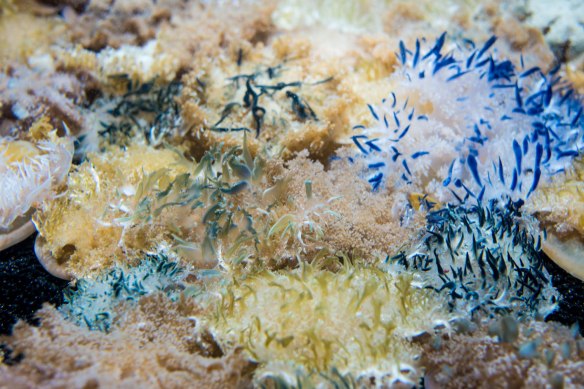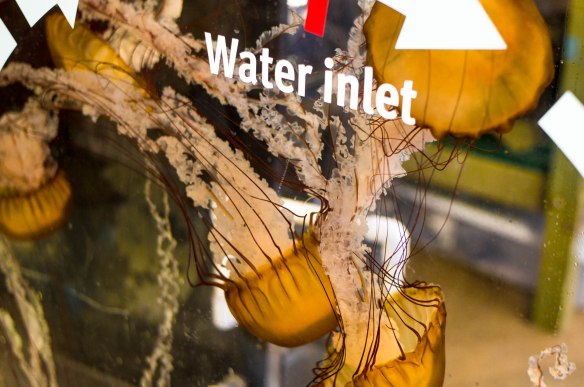“There is a thin semantic line separating weird and beautiful, and that line is covered in jellyfish.”
We went to the Monterey Bay Aquarium a few weekends ago for their Special Jellyfish Tour. Special Jellyfish Tours are the sort of thing that I do when I live within near geographical proximity to my parents. I do not know what this says about my family, exactly.
I’ve always liked jellyfish, in a relatively abstract way. I remember seeing a spectacular comb jellyfish (Ctenophora) pulsing gentle away behind the blue back-light of the Tennessee Aquarium and being incredulous, for a moment, that such a thing could exist in this world and not in cartoons. I thought about the possibility of building a tank for one in my room.
Other Jellyfish Facts percolated into me, largely through pressing my nose to aquarium glass in one place or another: upside down jellyfish that pulse aberrantly on the bottom of their tanks, lazy moon jellyfish percolating through the corners of their circular tanks, and — weirdest of all — the jellyfish reproduction method of stacking a whole bunch of jellyfish up onto a stalk (budding polyp) and than separating at the right time. I had a glow in the dark jellyfish toy that I treated with particular affection, especially in the bathtub where it bobbed realistically. There was even, as I recall, a jellyfish Beanie Baby. Named “Goochy.”
The parts of the US I frequented were rather low on jellyfish when I was a kid, and I first encountered the Real Thing in the flesh at a harbor in Perth, on the Swan River. I looked down idly at the black water surrounding the ship slips and discovered a veritable sea of pulsing moon jellyfish of all different sizes, dotting the water like gelatinous, alien stars. It was both horrifying and gorgeous. The Australians paid no attention.
Later, I ran on the beach and saw a few dozen jellyfish washed up upon the shore, here and there. I bent over and poked one with my finger – delicately at first, than more harshly. The jellyfish had surprising substance: it did not give like one might expect a liquid, but instead felt rather more like one of those gel stress balls everyone had on their desk back in 1995.
The tentacles were not in evidence. It was off-putting — to imagine jellyfish not as ethereal, amorphous things but as more solid, more substantial than I had previously given them credit for.
I took up scuba diving this year and have been lucky enough to not have any real-run ins, although I’m a big advocate of wearing full wetsuits just to be sure. I came up from a dive once noticing a red, two inch long and perfectly straight slash across my arm, which stung a little. Perhaps a jellyfish. They are hard to see underwater.
They are easy to see at the Monterey Bay Aquarium, which is one of the founders of world jellyfish husbandry and is justly proud of the fact. Jellyfish may look like rather simple creatures with decidedly limited enrichment needs, but are in fact obnoxiously difficult to keep in captivity. They are kept in circular tanks (called kreisels) because they have a perverse tendency to get caught in the corners and break themselves into pieces. Monterey Bay Aquarium experts figured out that they could use water to create a circular current, keeping the jellyfish circumnavigating about throughout their (brief) lives.
The Monterey Bay Aquarium (and other noble experts) have got the art pinned down so exactly that jellyfish are now en route to becoming a fad pet. You can even have them mailed direct to your home, plus shipping.
Over the course of the Special Jellyfish Tour, we were shepherded up elevators, down elevators, and through and around the back of various jellyfish tanks by an extremely excited woman in her sixties in a jaunty red coat with pens stuck to it, who had decided to devote her retirement to telling people about jellyfish in lieu of reading the bridge column.
“I can’t wait to tell you about this one!” she’d say, often, staring lovingly into a tank filled with pulsing, off-yellow aliens. She spoke of them in a protective fashion, as if they were a pack of pet Chihuahuas, or perhaps slightly mischievous grandchildren.
We then got to stroke a moon jellyfish, which the tour guide caught gently in her hand. They do not sting particularly, and can be safely touched. The moon jellyfish felt exactly like the late jellyfish I had encountered on the beach: more solid than anticipated.
She released the jellyfish, and it bobbed in a confused fashion in the tank for a minute — as confused as it is possible for an essentially brainless creature composed of animate jelly to be. Then it righted itself and began its slow circumnavigation of Jellyfish Prison again.
“Don’t touch your eyes,” the tour guide said. We washed our hands.

Regardless of my personal fondness for jellyfish, science tells me they are a terrible menace and I should fear them, or at least feel a reasonable sort of existential dread.
“Stung!: On Jellyfish Blooms and the Future of the Ocean” by Lisa-ann Gershwin proved a prescient and decidedly distressing read, wherein Gershwin describes in great but readable detail how our seas will eventually become choked with a great horror of pulsating, minimally-brained floating protein.
We shall have to grow used to eating jellyfish, living with jellyfish, perhaps fashioning clothing out of jellyfish. Scuba diving will become a much more pedestrian endeavor, where we’ll pay considerable sums to bob around amidst a sea of pulsating freaks — the entire world transformed into a rendering of Palau’s “Jellyfish Lake.”
Worse, we’ve brought this living Lava Lamp of a dystopian nightmare upon ourselves, with deep-sea trawling, pollution, and increasingly warm waters perfectly suited for our impending Cnidarian overlords. The Japanese are trying to convince everyone else that jellyfish taste good. They are the first vanguards.
Technology is trying to address the problem, including a perhaps ill-fated Korean jellyfish shredding robot — you can view a video of it in action swiftly liquefying moon jellyfish, which a blogger helpfully noted is “pretty graphic.”
You could probably write a thesis as to why the sight of a jellyfish being shredded evokes the mild discomfort in my psyche (and I suspect that of others) as that felt when watching a beautiful object destroyed — they are walking that “thin semantic line.”
Consider the jellyfish, then: they are both delicate and capable of ruining us entirely. They are the subjects of plush toys, art, and slightly-arms-length human fascination. We will cede the planet to them, soon enough.






